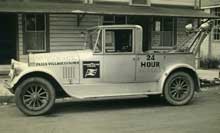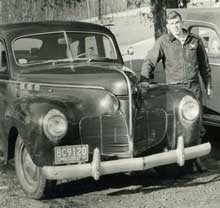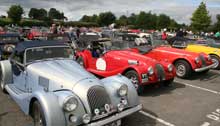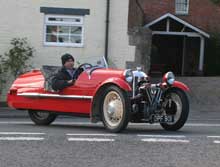Old Home Week
One neat thing about the internet is the way it can put you in touch with friends you haven't seen for many years. Not too long ago I heard from Midge Frueh Cortesi, whose father I used to work for in my Farmall era. We were able to share our memories of Falls Village, the northwest Connecticut hamlet where we grew up. Her sister, Lauriann Cardinali alerted me to a Falls Village automotive artifact on eBay, the photo that heads this feature.
Many of you will recognize it from its headlights as a Pierce-Arrow Model 33 from the early 1920s. It has been converted to a wrecker - you can see how it was cut down from a sedan in order to mount the wrecker boom. This was the fate of many old prestige cars in the 1930s - they were cheap, sturdy and powerful, well-suited to towing disabled cars or disentangling wrecks.
I remember Schreiber's Garage. We used to buy gas there, and have our car repaired. The Pierce wrecker was gone by the time we moved to town, replaced by a purpose-built 1935 Ford. I wondered, then, just when the photo was taken, so I began to look at it carefully.
The wrecker is parked in front of a small store on Main Street. The garage can be seen at the extreme right. The windows are open, so it must be a warm summer day. We can just see a car behind the wrecker, and on the car is a dealer plate (plates for new car dealers in Connecticut, then and now, start with X). Schreiber's was a Chrysler-Plymouth dealer, so not surprisingly the car is a Plymouth, a 1938 model, judging by the bumper guards. It looks pretty new and shiny, so perhaps the photo was taken that summer.
But there are other clues, in the shop window behind. The most obvious isn't much help. It advertises dry cleaning. But on the other side is a movie poster, from the Stuart Theater in nearby Lakeville. There's another one from the Colonial Theater in Canaan, the next town to the north. The Stuart burned on Christmas Day in 1958, but the Colonial is still standing - and operating.
On the posters, we can just make out the titles of two coming attractions, Lady of the Tropics and The Wizard of Oz. The extremely helpful Internet Movie Data Base tells us that Lady, starring Robert Taylor and Hedy Lamarr, opened on August 11, 1939. Wizard, starring Judy Garland, Frank Morgan, Ray Bolger and Bert Lahr, came two weeks later, on the 25th. So it is indeed a summer picture, taken at the end of July or beginning of August 1939.
Schreiber's closed around 1955. The owner had died, and his widow sold up and moved away. The building was later occupied by John Fitch & Co., headed by the renowned racing driver who built his Sprint conversions for Corvairs there, and developed the stillborn Phoenix by Fitch in 1966. It was later a grocery store. The building survives as 100 Main Street, home to Flying West Music, the studio of composer Joshua Stone.
So you can go home again, and the internet can take you there.




